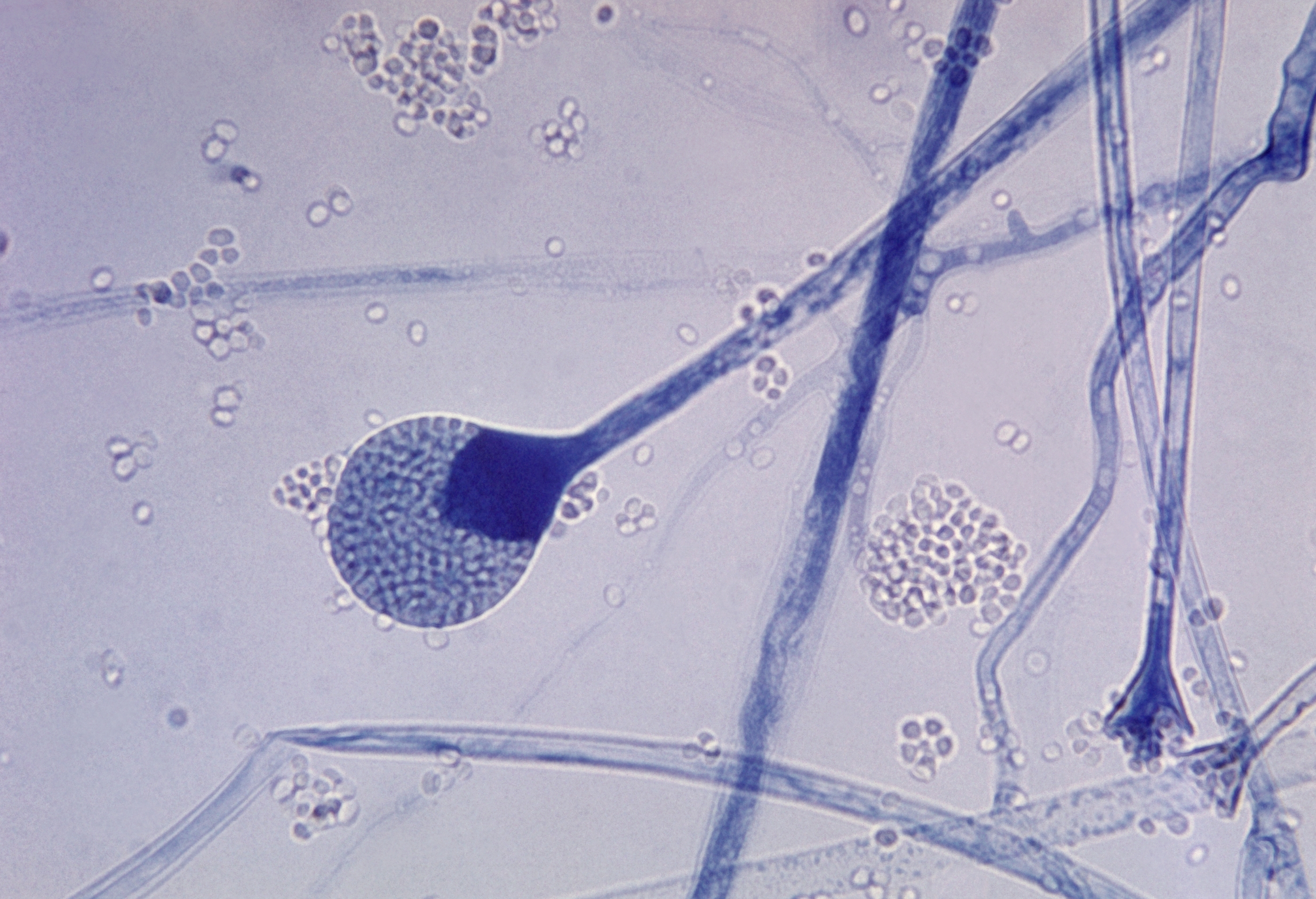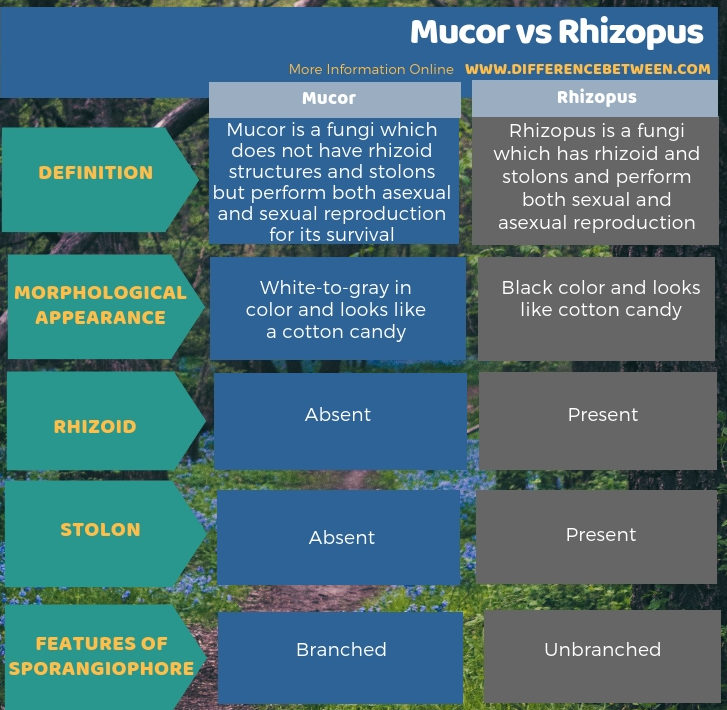Difference Between Mucor and Rhizopus
Table of Contents
The key difference between Mucor and Rhizopus is the structural features of the two fungi. Mucor does not have rhizoids and stolons while Rhizopus has both rhizoids and stolons in their structures.
Mucor and Rhizopus are two fungi belonging to the Kingdom Fungi. They belong to the phylum Zygomycota. Moreover, they are filamentous fungi which have a varied distribution across many environments. They also have a distinct way of reproduction using sporangiophore. Both organisms are used in various industries.
CONTENTS
1. Overview and Key Difference
2. What is Mucor
3. What is Rhizopus
4. Similarities Between Mucor and Rhizopus
5. Side by Side Comparison – Mucor vs Rhizopus in Tabular Form
6. Summary
What is Mucor?
Mucor is a zygomycetes fungus of kingdom Fungi. It is a mold or a filamentous fungus. These fungi are commonly found in soil environments, rotten or spoiled vegetable matter or food surfaces and in some digestive systems. They are fast-growing filamentous fungi that appear to be white to grey in color. Moreover, they are saprotrophic and depend on the decomposing organic matter in the environment.

Figure 01: Mucor
Mucor reproduces through sexual and asexual reproduction. Asexual reproduction in Mucor takes place through fragmentation and through sporangiophore formation. The sporangiophore of Mucor is branched. Upon maturity, the sporangiophore develops into a sporangium and releases asexual spores. These asexual spores then develop into new functional Mucor mycelia.
Sexual reproduction in Mucor takes place through the mating of the two types of organisms. Sexual reproduction in Mucor takes place under harsh unfavorable conditions. Moreover, the gametangia of Mucor reproduce via conjugation.
What is Rhizopus?
Rhizopus belongs to the Phylum Zygomycota of kingdom Fungi. They are soil organisms but are also found in surfaces of rotten food. They have a distinct body structure composed of rhizoids and stolons. These fungi anchor to the soil by their rhizoids. Moreover, rhizoids help to absorb nutrients from the soil. Their colonies are black in colour.

Figure 02: Rhizopus
Similar to Mucor, Rhizopus also show both asexual and sexual reproduction patterns. Vegetative reproduction takes place via fragmentation and the production of asexual spores inside the unbranched sporangiophores. Meanwhile, sexual reproduction takes place through gamentagial conjugation in Rhizopus. Moreover, Rhizopus is an industrially important fungus.
What are the Similarities Between Mucor and Rhizopus?
- Mucor and Rhizopus are two fungi that belong to kingdom Fungi and phylum Zygomycota.
- Both organisms show heterotrophic nutrition.
- Also, they are saprotrophs.
- Both carry out extracellular digestion.
- Their hyphae are branched.
- Moreover, the cell wall of both fungi is composed of chitin.
- Besides, both fungal species are found in soil and in rotten food surfaces.
- They reproduce via both asexual and sexual methods.
- Vegetative reproduction takes place via fragmentation in both fungi.
- Furthermore, sporangiophore contains asexual spores that are important in asexual reproduction of both organisms.
- Sexual reproduction takes place through gametangial conjugation in both Mucor and Rhizopus.
What is the Difference Between Mucor and Rhizopus?
Mucor and Rhizopus are two types of filamentous fungi which are molds. They look alike. But they can be distinguished by the presence or absence of rhizoids and stolons. Mucor does not have rhizoids and stolons while Rhizopus has rhizoids and stolons. So, we can consider this as the key difference between Mucor and Rhizopus. Furthermore, a significant morphological difference between Mucor and Rhizopus is that the Mucor looks like white cotton candy colonies whereas Rhizopus appears as black color cotton candy colonies.
Moreover, though both fungi produce sporangiophores, Mucor has branched sporangiophores while Rhizopus has unbranched sporangiophore. Therefore, this is also a difference between Mucor and Rhizopus.
The following infographic presents more information regarding the difference between Mucor and Rhizopus.

Summary – Mucor vs Rhizopus
Mucor and Rhizopus are two fungi belonging to the same phylum – Zygomycota and kingdom – Kingdom Fungi. But there is a structural difference between Mucor and Rhizopus. Mucor does not have rhizoids and stolon whereas Rhizopus has rhizoids and stolons. This is the key difference between Mucor and Rhizopus. In addition, their appearance also differs. Mucor appears to be white to grey in color. In contrast, Rhizopus forms black color colonies.
Reference:
1. “Mucor: Description, Structure and Reproduction.” Biology Discussion, 24 Aug. 2016, Available here.
2. N, Supriya. “What Is Rhizopus? Features, Structure and Reproduction.” Biology Reader, 14 Feb. 2019, Available here.
Image Courtesy:
1. “Mature sporangium of a Mucor sp. Fungus” CDC/Dr. Lucille K. Georg – Centers for Disease Control and Prevention’s Public Health Image Library (PHIL), with identification number #3960.Note: Общественное достояние via Commons Wikimedia
2. “فطر رازبة (rhizopus )” By Sabamohammad – Own work (CC0) via Commons Wikimedia
ncG1vNJzZmivp6x7pbXFn5yrnZ6YsqOx07CcnqZemLyue8OinZ%2Bdopq7pLGMm5ytr5Wau2651Jymq2WRo7Fuvseisaiopah8